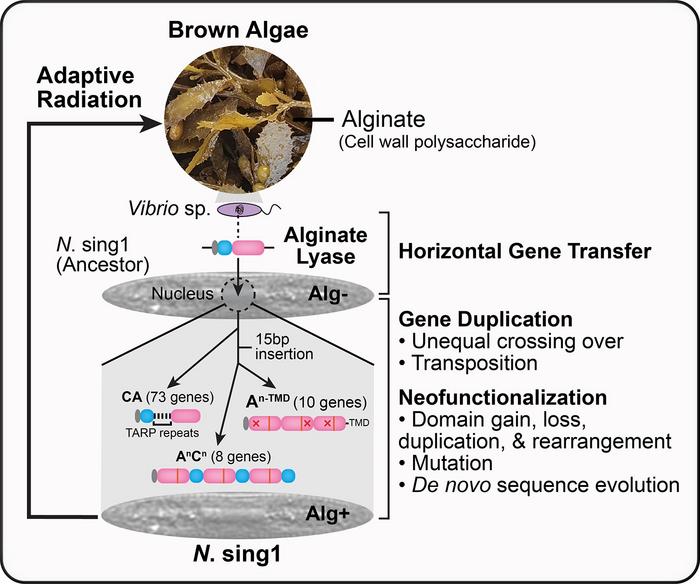A revolutionary discovery in evolutionary biology has just emerged from the coastal waters, illuminating the complex interplay between genes and dietary habits in diatoms, a diverse group of single-celled algae. Researchers from Temasek Life Sciences Laboratory, Singapore, have unearthed startling revelations about how some diatom species forsake the long-held practice of photosynthesis, a hallmark of their ancestral lineage, to embrace a heterotrophic lifestyle that allows them to harvest nutrients directly from their environment. This paradigm shift in metabolic strategy is believed to stem from an extraordinary event of genetic acquisition from marine bacteria, showcasing the remarkable adaptability of these organisms.
In a study published in PLOS Biology on April 1, the team detailed the genetic mechanisms that have facilitated this transition for members of the Nitzschia genus, particularly focusing on a species named Nitzschia sing1. The findings challenge conventional understanding of diatom ecology and evolution, which had long emphasized photosynthesis as the cornerstone of their survival and propagation. Instead, the revelation that certain diatoms have acquired the ability to directly consume carbohydrates from algal and plant materials presents a compelling narrative about the influence of environmental pressures and evolutionary adaptability.
Sequencing the genome of N. sing1 revealed a treasure trove of genetic information, including a notable gene coding for an enzyme capable of breaking down alginate, a carbohydrate polymer found in the cell walls of brown algae. This enzyme is pivotal for N. sing1’s new diet, as it allows the organism to convert the alginate into usable carbon units, effectively turning it into a carbon ‘hunter’ rather than a simple photosynthesizer. The gene’s origin is particularly fascinating—it is believed to have been absorbed from a marine bacterium, marking it as a prime example of horizontal gene transfer, a process where genetic material is exchanged between organisms in a manner other than traditional reproduction.
What makes N. sing1’s adaptation even more intriguing is the evolutionary pathway it seems to have taken following the initial gene acquisition. Researchers discovered that this gene underwent multiple duplications and accumulated mutations, each modification conferring new functions. This concept, known as neofunctionalization, is key to understanding how a single genetic innovation can lead to a plethora of new biological capabilities. Through this evolutionary lens, the journey of N. sing1 titillates the imagination, as it highlights not just the mechanisms of adaptation but the potential for future diversification among diatoms.
However, N. sing1 is not alone in the Nitzschia genus; there lie many other relatives that also inhabit various ecological niches. Some of these species are considered non-photosynthetic as well, yet they exhibit different approaches to carbon sourcing. This suggests a rich tapestry of evolutionary strategies at play among diatoms, waiting to be unraveled by subsequent genomic explorations. The researchers advocate for increased sampling and genomic analysis of diverse Nitzschia species, which could yield further insights into their respective metabolic strategies and adaptations.
The ecological implications of this research are vast. Understanding how these diatoms have evolved to exploit brown algae as a food source opens new avenues for exploring carbon cycling in coastal ecosystems. Since coastal waters are often zones of high biodiversity and productivity, understanding the role of heterotrophic diatoms within these habitats can shed light on nutrient dynamics, species interactions, and ecological stability. The capacity of diatoms like N. sing1 to thrive in intertidal zones by utilizing detritus broadens our comprehension of energy flow within these environments.
As we grapple with the consequences of climate change and habitat degradation, insights gained from studies like this can inform conservation efforts aimed at protecting coastal ecosystems. The adaptive strategies demonstrated by N. sing1 may also inspire biomimicry in engineering, biotechnology, and even sustainable resource management. Furthermore, examining gene transfer mechanisms may offer pivotal holds on advancements in genetic engineering and synthetic biology, connecting ecological discovery with practical applications.
The researchers’ findings not only trace evolutionary origins but also illuminate the inherent complexities embedded within metabolic capabilities. This intricate narrative enhances our understanding of diatoms, revealing their remarkable resilience and innovation in the face of environmental challenges. As further research unfolds, it may unveil even more surprises regarding their metabolic versatility and evolutionary potential, propelling diatoms into a new light within the scientific community.
In closing, the research published on the evolutionary capacity of Nitzschia sing1 stands as a testament to the power of interdisciplinary inquiry, merging molecular biology, evolutionary science, and ecology. It challenges us to rethink existing paradigms and embrace the intricacies of life on Earth. As we continue to explore the oceans and unravel the genetic secrets they house, we are compelled to reconsider our understanding of life’s adaptability amid shifting environmental landscapes.
This groundbreaking study promises to fuel further exploration into the realms of genetic evolution among microorganisms, with implications that resonate far beyond the shores where these organisms thrive. The journey from photosynthesis to heterotrophy encapsulates a profound story of survival, innovation, and evolutionary creativity, urging us to delve deeper into the mysteries of life that adapt to our ever-changing world.
Subject of Research: Nitzschia genus diatoms and genetic adaptations
Article Title: Diatom Heterotrophy on Brown Algal Polysaccharides Emerged Through Horizontal Gene Transfer, Gene Duplication, and Neofunctionalization
News Publication Date: April 1, 2025
Web References: DOI: 10.1371/journal.pbio.3003038
References: Lim ZH, Zheng P, Quek C, Nowrousian M, Aachmann FL, Jedd G (2025) PLOS Biology
Image Credits: Jedd Group (CC-BY 4.0)
Keywords: Nitzschia, diatoms, heterotrophy, evolution, horizontal gene transfer, alginate, carbon cycling, ecological adaptation.




